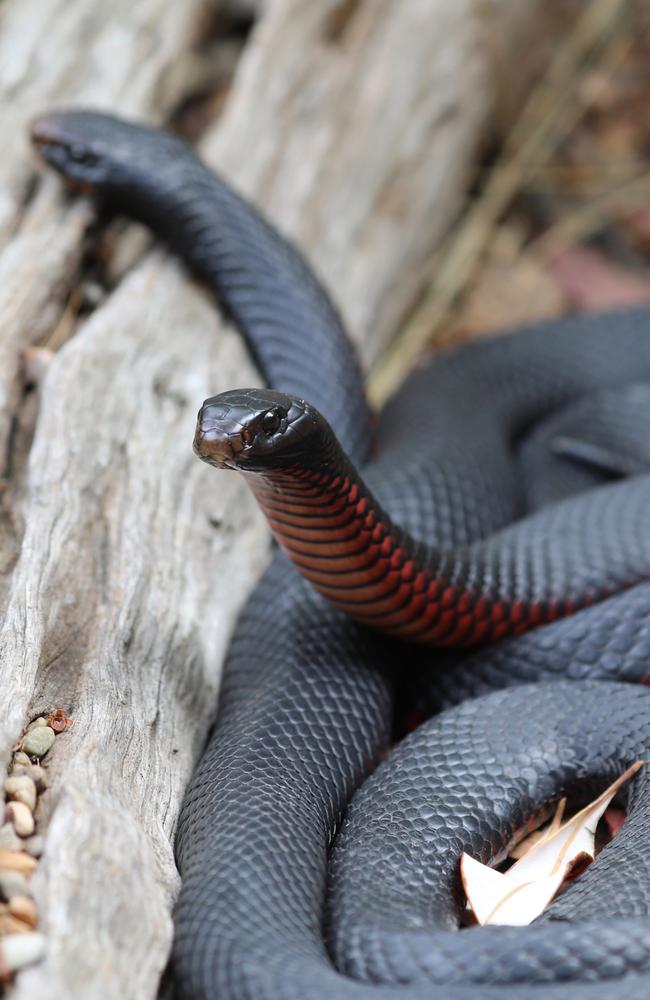Grandmother tells how she survived red-bellied black’s deadly bite
A Brisbane grandmother has revealed her harrowing story of survival after a red-bellied black snake bite in the hope of helping others avoid an agonising death.
QLD News
Don't miss out on the headlines from QLD News. Followed categories will be added to My News.
As the state gears up for a deadly summer of snake activity, a Brisbane grandmother reveals how she survived a red bellied black snake bite in the hope of helping others know how to avoid an agonising death.
Heather-lee Ollington grew up in PNG where snakebite deaths are common. When she hikes she always carries compression bandages, and on the day she went for a walk on Mt Nebo those bandages helped save her life.
Ms Ollington was hiking alone when she needed to go the toilet.
“I stepped over a log and was bitten on the foot by the red bellied black. I immediately dropped to the ground and bandaged my foot. I froze there for a couple of hours and I phoned my sister to come and get me. One of the biggest mistakes you can make is to race to get help once you are bitten. The venom travels through the lymphatic system so it is vital not move and wait for someone to come and carry you or to be stretchered by an ambulance,” she said.

Another common mistake is for the bite victim to go looking to see what type of snake attacked.
“It will only cause further bites and ultimately it doesn’t matter as the same polyvalent anti venom is used for all bites,” Ms Ollington said.
“I have been a health worker and I know about snake bites so I was able to monitor myself but people should call for an ambulance to get help,” she said.
When she got home and unwrapped the bandages she began to feel the symptoms of the bite.
“I felt muscle pain and nausea so decided it was time to get medical help. I didn’t get the anti venom. Medics will monitor cases and avoid the anti venom if it is not needed as it can cause problems itself,” the grandmother to 12 said.
Side-effect from anti venom can cause rapid heart rate or fever.
“About five days after the bite I felt fully recovered.”
Ms Ollington said that knowing how to react after a snake or spider bite will save lives this summer.
Her advice is that if you are bitten while alone and have a pen with you, circle where the bite is and write the time of the bite in case you pass out.
The state’s snake catchers are reporting a surge in the sightings of deadly breeds like red-bellied blacks or brown snakes.
Bill Nimorakiotakis a medical officer with the Royal Flying Doctor Service and Retrieval Services Queensland reports he has seen an increase in snake bites.
“Areas that have suffered flooding are usually hot spots as the snakes move to higher ground,” he said.

The doctor reassures Queenslanders that hospitals around the state are well equipped to deal with snake bites and regional and rural centres have anti venom.
“If the area is very remote we will meet them with the anti venom,” he said.
The doctor said that when people are bitten by a snake there is panic all around and sometimes first aid can be forgotten.
“I know that there are cases where the person needs CPR but it is not administered. The automatic thought is that they must have anti venom. If there is no sign of life, give CPR,” he said.
Dr Nimorakiotakis told The Courier-Mail that when snake venom enters the body, neurotoxicity causes paralysis which is easily identifiable.
“But it also causes blood coagulation problems and when the blood can’t clot that is a hidden danger,” he said.
“Hospital treatment is the only way to go. Don’t hold back,”
Saturday is the first national Venomous Bites and Stings Day.
QUEENSLAND SNAKES
TREE SNAKES
Slender and agile snakes which are harmless and often retreat from humans.
They’re found widespread along the east coast and can grow up to 2m in length.
Tree snakes’ prey includes frogs, birds, reptiles and occasionally small mammals.
CARPET PYTHONS
Slow-moving, non-venomous constrictors which prey on birds and mammals.
Normally grow between two and four metres long.
Found throughout Queensland from the coast to inland.
BROWN SNAKES
Fast-moving and sun-loving, eastern browns are the most common brown found in Queensland.
They’re often found near houses and sheds in search of rats, mice and lizards.
Average about 1.5m in length but can grow to 2.4m.
Eastern browns can strike with extreme speed and ferocity.
RED-BELLIED BLACKS
Active during the day and night, found near swamps, lagoons, streams and forests.
Typically a shy snake which can reach 2m in length.
TAIPAN
Australia’s deadliest snake with a maximum length of more than 3m.
Mainly prey on rats and mice but are commonly found in sheds, farms and waste heaps.
Taipans can strike with speed and accuracy however, humans are rarely bitten.
Note: It is illegal to keep and kill snakes
Source: Qld Department of Environment and Science




